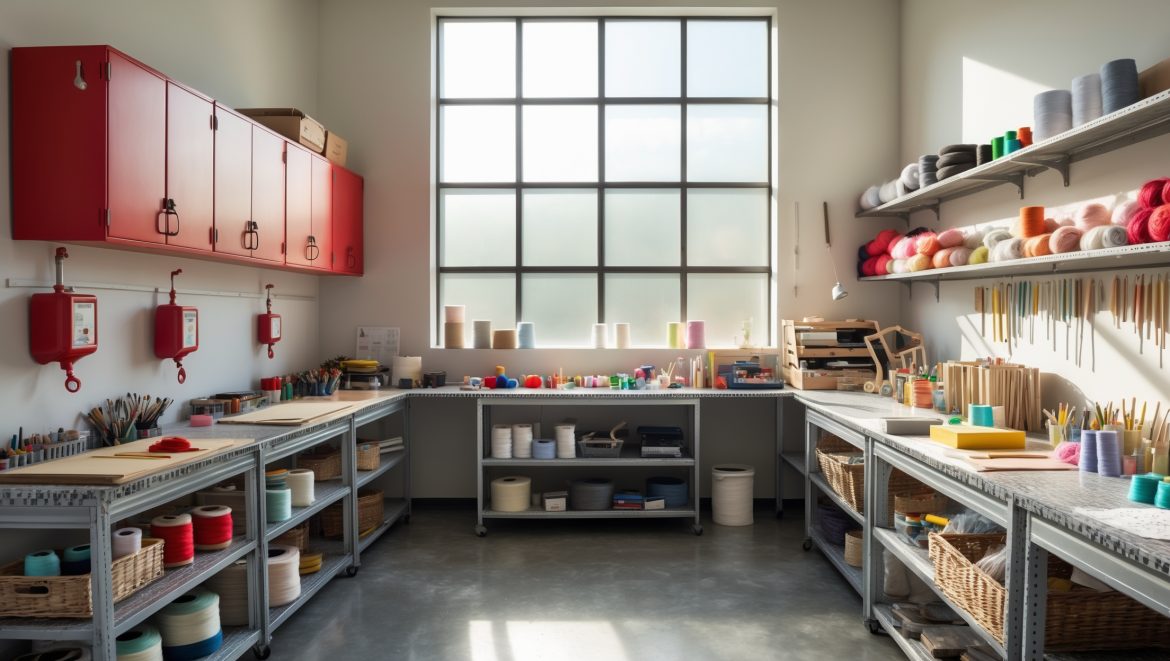Introduction: Why Fireproofing Matters in Your DIY Craft Studio
Every passionate crafter knows the exhilaration that comes with creating something from scratch. Whether you’re a woodworker, jewelry maker, fiber artist, or mixed media enthusiast, your studio is the heart of your creative world. But with all the inspiration and energy, it’s easy to overlook a critical aspect of your workspace: fire safety. Craft studios can be uniquely vulnerable to fire hazards due to the presence of flammable materials, heat-producing tools, and sometimes even open flames. Fireproofing isn’t just about compliance or peace of mind—it’s about safeguarding your projects, tools, investments, and, most importantly, yourself. This comprehensive guide walks you through practical, actionable strategies for fireproofing your DIY craft studio, from selecting the right materials to smart layout decisions and affordable, effective upgrades you can implement yourself. Let’s ensure your creativity stays safe and unstoppable.
Understanding Fire Risks in Craft Studios
Common Fire Hazards in Crafting Spaces
- Flammable Materials: Fabric, paper, wood, solvents, paints, and adhesives are all common in craft studios and can catch fire quickly.
- Heat-Generating Tools: Soldering irons, heat guns, kilns, hot glue guns, and even some lighting fixtures create ignition risks.
- Electrical Overloads: Multiple tools plugged into the same outlet or improper extension cord use can spark electrical fires.
- Improper Storage: Storing flammable supplies near heat sources or without proper containment increases risk.
Understanding these hazards is the first step toward a safer, more resilient creative space.
Choosing Fire-Resistant Materials for Your Studio
Flooring
- Ceramic Tile: Non-combustible and easy to clean, ideal for areas near heat tools.
- Concrete: Durable, fire-resistant, and can be sealed for easy maintenance.
- Engineered Stone: Excellent for workstations, though costlier.
Avoid carpets and untreated wood flooring in high-risk zones.
Work Surfaces
- Stainless Steel: Highly fire-resistant and easy to wipe clean. Ideal for heat tool stations and soldering areas.
- Glass: Tempered glass can handle heat, though it’s best for areas where impact is unlikely.
- Fire-Retardant Treated Wood: If you prefer wood, opt for products treated with fire-retardant chemicals.
Wall and Ceiling Materials
- Type X Drywall: Contains glass fibers for enhanced fire resistance; use for walls and ceilings.
- Cement Board: Particularly good behind kilns, ovens, or soldering stations.
- Intumescent Paint: Apply to surfaces to add a layer of fire protection without major renovations.
Storage Solutions
- Metal Cabinets: Store flammable liquids, aerosols, and solvents in dedicated fire-resistant metal cabinets rated for chemical storage.
- Fireproof Safes: Use for storing valuable projects, digital backups, or critical documents.
Designing a Fire-Safe Studio Layout
Smart Zoning
Divide your studio into zones based on activity and risk:
- Hot Zone: For soldering, fusing, or using heat tools. Use non-combustible surfaces and keep clear of flammable supplies.
- Storage Zone: Separate from heat sources, for keeping materials and finished projects.
- Work Zone: General crafting, away from direct heat or open flames.
Safe Storage Placement
- Place flammable supply cabinets at least three feet from any heat source.
- Keep exit routes unobstructed and ensure doors open outward for easy escape.
Ventilation and Airflow
Proper airflow reduces the risk of fume buildup that could ignite. Install exhaust fans near heat-producing equipment and ensure windows can open easily.
DIY Fireproofing Upgrades You Can Implement
Heat-Resistant Mats and Pads
Place silicone or ceramic mats under soldering stations, hot glue guns, and heat presses to catch stray sparks and drips.
Fire-Resistant Curtains and Blinds
Replace fabric curtains with those made from fiberglass or other fire-resistant materials, especially near workbenches and windows.
Intumescent Seals and Caulks
Seal gaps around doors, windows, and penetrations with intumescent caulk to slow fire spread and smoke infiltration.
Strategic Use of Fire Blankets
Mount fire blankets on the wall in easily accessible locations. These can smother small fires before they spread.
DIY Fire-Resistant Storage Boxes
Line metal storage boxes with ceramic fiber blankets or fire-retardant board for a budget-friendly upgrade.
Essential Fire Safety Equipment
Fire Extinguishers
- Type ABC: Suitable for most craft studio fires (combustibles, liquids, electrical).
- Placement: Mount near exits and at least one in every zone. Check inspection dates regularly.
Smoke and Heat Detectors
- Install interconnected smoke alarms in all areas; consider adding heat detectors above hot zones.
- Test monthly and replace batteries twice a year.
Emergency Lighting
- Install battery-operated emergency lights and illuminated exit signs for safe evacuation during power loss.
First Aid and Burn Kits
- Keep a kit stocked with burn dressings, sterile pads, and instructions for treating minor burns and injuries.
Electrical Safety for Fire Prevention
Proper Outlet Use
- Plug high-wattage tools directly into wall outlets.
- Use surge protectors with overload protection for groups of small devices.
Extension Cord Safety
- Use only heavy-duty, grounded extension cords rated for your tools.
- Never daisy-chain cords or power strips.
Routine Inspections
- Check cords, plugs, and outlets regularly for signs of wear or overheating.
- Replace damaged equipment immediately.
Fireproofing for Specialty Craft Activities
Woodworking
- Keep sawdust contained and dispose of regularly; dust is highly flammable.
- Install spark arrestors on power tools where possible.
Ceramics and Kilns
- Place kilns on non-combustible stands at least 18 inches from the wall.
- Install a dedicated heat shield or cement board wall behind kilns.
Jewelry Making
- Use fire bricks and heat shields under soldering stations.
- Store torches and fuel canisters in a ventilated metal cabinet.
Craft Studio Fireproofing Checklist
- Non-combustible flooring in high-risk zones
- Fire-resistant work surfaces and wall coverings
- Metal or fireproof storage for flammable supplies
- Clear zoning of hot, work, and storage areas
- Heat-resistant mats under all hot tools
- ABC fire extinguishers near exits and workstations
- Smoke and heat detectors, tested monthly
- Emergency lighting and illuminated exit paths
- First aid and burn kits within easy reach
- Safe electrical setup: no overloads, checked regularly
- Specialty fireproofing for kilns, soldering, and woodworking
Maintenance and Ongoing Safety Practices
Monthly and Seasonal Checks
- Test all alarms, check extinguisher pressure gauges, and inspect cords and outlets.
- Review and update your fire safety plan every season or after adding new tools.
Safe Habits
- Never leave heat tools unattended while powered on.
- Store solvents and flammable supplies immediately after use.
- Keep walkways and exits clear of clutter at all times.
- Practice evacuation drills if your studio is in a shared or public building.
Conclusion: Protecting Your Creative Haven
Fireproofing your DIY craft studio isn’t a one-time project—it’s an ongoing commitment to safe, inspired creativity. By choosing fire-resistant materials, designing a smart layout, and implementing targeted upgrades, you not only reduce your risk but also foster peace of mind and confidence in your workspace. With every heat-resistant mat, fireproof cabinet, and smoke alarm, you’re not just protecting tools and projects—you’re ensuring that your creative journey continues uninterrupted, no matter what. Don’t wait for a close call to take action: audit your studio, make a list of priority upgrades, and set a realistic schedule for implementing them. Involve fellow crafters, share your fireproofing wins, and keep learning. A safer studio means more time for what truly matters—unleashing your imagination. Remember, every masterpiece deserves a secure home; make fireproofing a cornerstone of your creative practice today.



Are there specific brands or types of fire-resistant sealants for concrete floors that are easy to apply for someone totally new to DIY upgrades?
For beginners, look for fire-resistant sealants labeled as intumescent or firestop caulk. Brands like 3M Fire Barrier and Red Devil Fire Block are popular options and come in easy-to-use caulking tubes. Application is similar to standard caulk—just cut the tip, apply along joints or cracks, and smooth with a tool or gloved finger.
I’m interested in the flooring options you mentioned, like ceramic tile and engineered stone. Are there any specific brands or products you recommend for a small craft studio on a budget?
For a small craft studio on a budget, you might consider brands like Daltile for ceramic tiles, which are widely available and offer budget-friendly lines. For engineered stone, brands like MSI and Silestone sometimes have affordable options, especially in smaller formats or clearance sections. Local home improvement stores often carry these brands and may have deals on discontinued styles that work well for craft spaces.